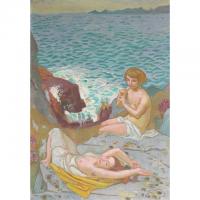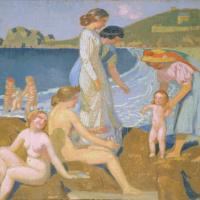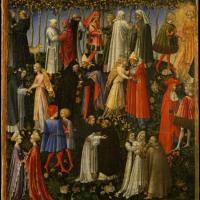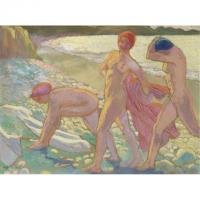Maurice Denis
Maurice Denis
Maurice Denis (1870-1943)
Maurice Denis (25 November 1870 – 13 November 1943) was a French painter, decorative artist and writer, who was an important figure in the transitional period between impressionism and modern art. He was associated with Les Nabisthen the Symbolist movement, and then with a return to neo-classicism. His theories contributed to the foundations of cubism, fauvism, and abstract art. Following the First World War, he founded the Ateliers d'Art Sacré (Workshops of Sacred Art), decorated the interiors of churches, and worked for a revival of religious art.
Maurice Denis was born 25 November 1870, in Granville, Manche, a coastal town in the Normandy region of France. His father was of modest peasant origins; after four years in the army, he went to work at the railroad station. His mother, the daughter of a miller, worked as a seamstress. After their marriage in 1865, they moved to Saint-Germain-en-Laye in the Paris suburbs. His father was employed in the offices the administration of the Western Railroads in Paris.
Maurice was an only child. From an early age, his passions were religion and art. He began keeping a journal in 1884 at the age of thirteen. In 1885 he recorded in his journal his admiration for the colors, candle light and incense of the ceremonies at the local church. He frequented the Louvre, and admired especially the works of Fra Angelico, Raphael and Botticelli. At the age of fifteen he wrote in his journal, "Yes, I must that I become a Christian painter, that I celebrate all the miracles of Christianity, I feel that is what is needed." In 1887 he discovered a new source of inspiration, the works of Puvis de Chavannes.
Denis was accepted as a student at one of the most prestigious Paris schools, the Lycée Condorcet, where he excelled at philosophy. However, he decided to leave the school at the end of 1887 and in 1888 enrolled in Académie Julian to prepare for the entrance examination to the École des Beaux-Arts in Paris. There he studied with the painter and theorist Jules Joseph Lefebvre. He passed the entrance examination for the Beaux-Arts in July 1888, and passed another examination in November to receive his baccalaureate in philosophy.
For his technique, Denis was first drawn toward the neoimpressionist style of Seurat, but rejected it as too scientific. In 1889, Denis was captivated by an exposition of works of Gauguin and his friends at the Cafe Volponi, on the edge of the Paris Universal Exposition of 1889. The Nabis drifted apart by the end of the 1880s, but their ideas influenced the later work of both Bonnard and Vuillard, as well as non-Nabi painters like Henri Matisse.
Another influence on Denis at the time was the art of Japan. His paintings in the Japanese style featured a wide format and very stylized composition and decoration, appearing like Japanese screens.
Another topic he addressed in this period was the relationship between sacred love and profane love. The painting had three female figures, two nude and one clothed, following the model of Le Concert Champêtre and L'Amour Sacré et L'Amour Profaneof Titian and Déjeuner sur l'herbe by Manet. The setting is his own garden, with the viaduct of Saint-Germain-en-Laye in the background. The nude figures represented sacred love, and he clothed figure profane love. He made another painting, this time of Marthe nude in the garden, representing both sacred and profane love in one figure.
In the mid-1890s, with the appearance of the Art Nouveau style in Brussels and Paris, Denis began to pay greater attention to the decorative arts, though his themes of family and spirituality remained the same. Many of his new projects were commissioned by Samuel Bing, the art dealer whose gallery gave its name to Art Nouveau. His new projects included designs wallpapers, stained glass, tapestries, lamp shades, screens, and fans. But while he worked within the time period and used the materials of the Art Nouveau, his themes and style remained distinctly his own.
From 1899 to 1911 Denis was also busy with graphic arts. The last work, made during the midst of the First World War was more somber than his earlier work, largely colored in pale blues an greys.
In 1908 Denis began work on an important decorative project for the Russian art patron Ivan Morozov, who had been a major patron of Claude Monet and Auguste Renoir, and who owned The Night Cafe by Vincent Van Gogh.
Beginning in 1909, he taught painting at the Académie Ranson in Paris, where his students included Tamara de Lempicka.
In the last period of his life and work he turned his attention more and more to large-scale murals and to religious art. He completed twenty murals between 1916 and his death in 1943.
In the late 1920s and 1930s, his prestige was such that he received commissions for a number of murals for important civic buildings.
In his later years, he also had two important commissions outside of France, both on his favorite theme of Christian faith and humanism; the first, in 1931, for the Offices of the International Labor Bureau in Geneva, commissioned by the International Association of Christian Workers in Geneva on the theme "Christ preaching to the workers"; and the second, in 1938, for the new headquarters of the League of Nations. on the theme of being armed for peace, depicting a figure of Orpheus taming the tiger of war.
In January 1940, in his sixtieth year, he summed up his accomplishments in his journal: "My marriage: Delacroix admired and understood; Ingres abandoned; break with the extremists. I have become official while at the same time cultivating the secret inquietude of an art which expresses my vision and my thought, while at the same time forcing me to better realize the lessons of the masters." Denis died in Paris of injuries resulting from an automobile accident in November 1943. (The date of his death is variously listed as the 2nd, 3rd, or 13th.)







